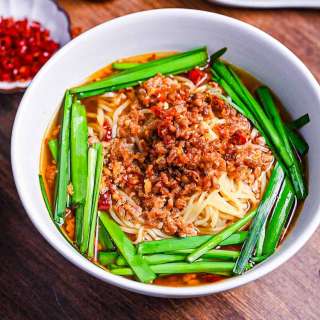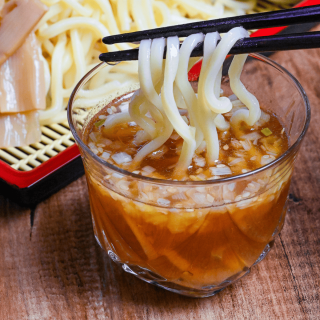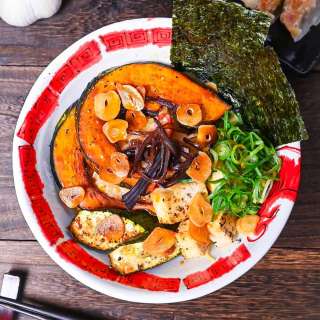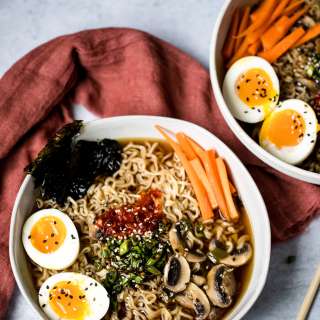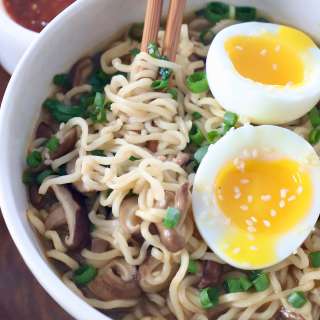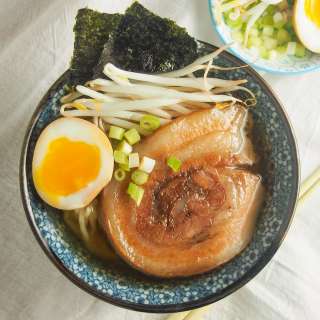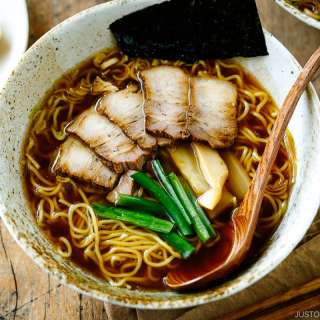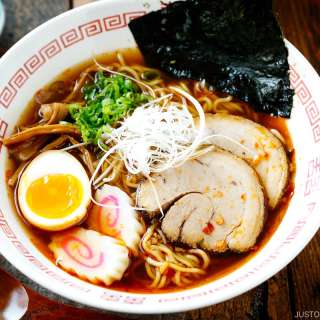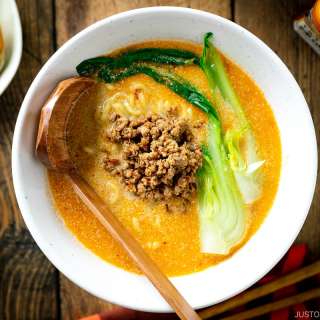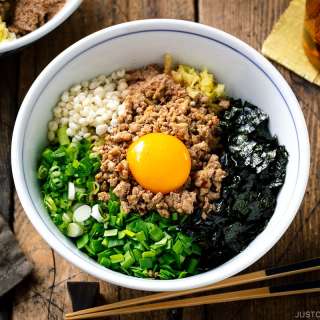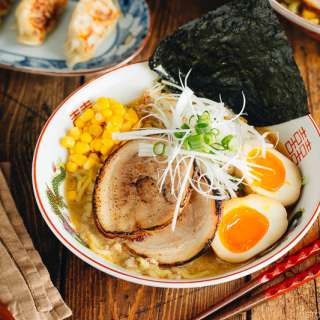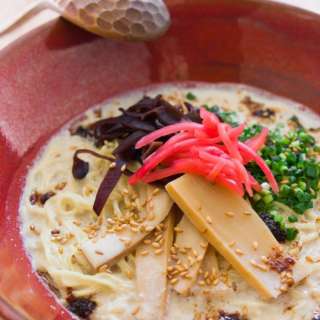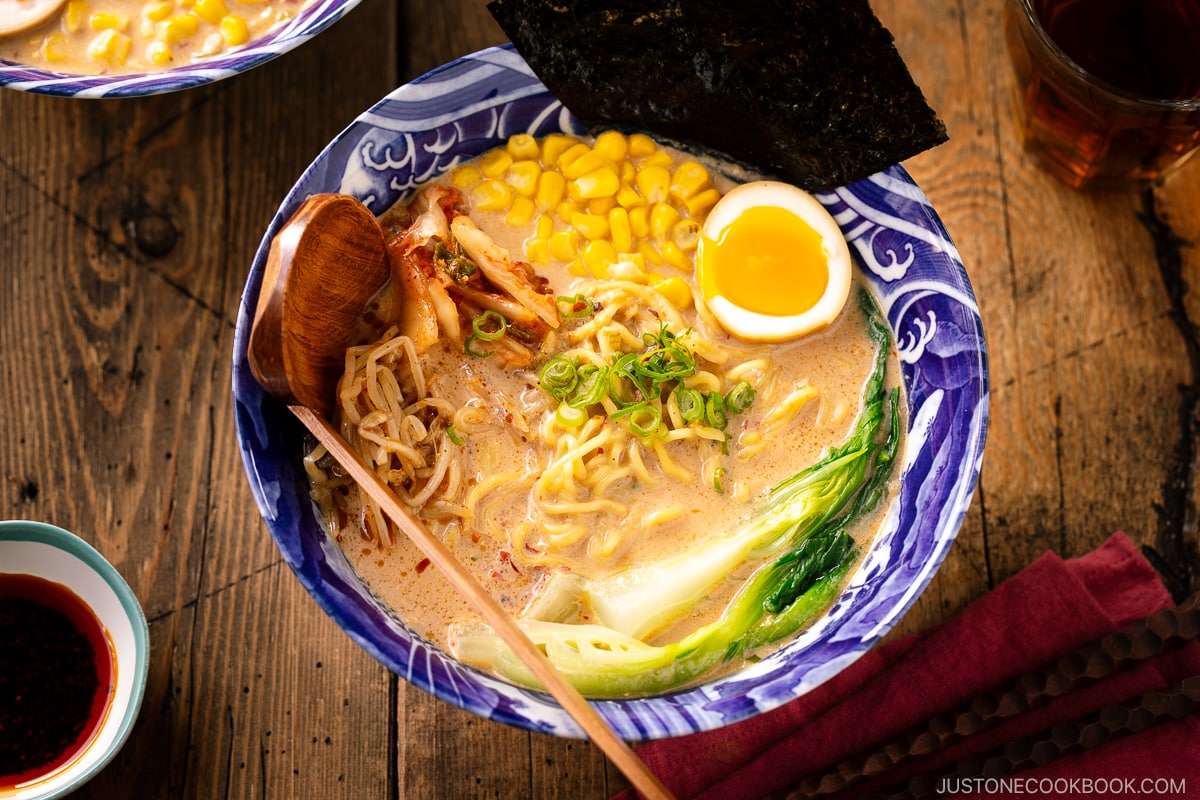
Vegetarian Ramen
User Reviews
4.8
1,173 reviews
Excellent
-
Prep Time
10 mins
-
Cook Time
10 mins
-
Additional Time
30 mins
-
Total Time
1 hr
-
Servings
2
-
Calories
471 kcal
-
Course
Main Course
-
Cuisine
Japanese

Vegetarian Ramen
Report
This Vegetarian Ramen is going to rock your world! Learn the secret to creating a superrich and creamy broth with soy milk, miso, sesame seeds, and spicy chili bean sauce. Make it vegan by skipping the ramen egg!
Share:
Ingredients
For the Soup Broth
- 2 Tbsp toasted white sesame seeds
- 1½ tsp ginger (grated; from a 1-inch, 2.5-cm knob)
- 2 cloves garlic
- 2 green onions/scallions (save the green part for garnish)
- 1 Tbsp toasted sesame oil
- 1½ Tbsp doubanjiang (spicy chili bean paste) (use either the spicy or non-spicy type, or use gluten-free doubanjiang)
- 1½ Tbsp miso (I use my favorite miso by Hikari Miso; most types will work, except Saikyo and Hatcho varieties)
- 1 Tbsp sake
- 1½ Tbsp soy sauce (use GF soy sauce for gluten-free)
- 2 cups unsweetened soy milk
- 1 cup Vegan Dashi (use my Vegan Dashi recipe or follow the instructions below)
- ½ tsp Diamond Crystal kosher salt
- 1 dash of white pepper powder
For the Ramen
- 2 ervings fresh ramen noodles (10–12 oz, 283–340 g fresh noodles; 6.3 oz, 180 g dry ramen noodles; use GF ramen noodles for gluten-free)
- 1 head Shanghai bok choy (large)
- toppings of your choice (I like to add ramen eggs (skip for vegan), corn, nori seaweed, vegan kimchi, and spicy bean sprout salad; see the instructions for details)
Instructions
- Gather all the ingredients. If you haven‘t already made the vegan dashi, prepare my Vegan Dashi recipe or follow the instructions below. Make sure all the toppings are ready to go before you begin cooking the ramen. If you‘re making my Ramen Eggs recipe (1 per bowl), prepare them a day in advance. I also like to divide and add ½ cup of my Spicy Bean Sprout Salad and ¼ cup of my friend Seonkyoung‘s homemade vegan kimchi. Finally, ¼ cup corn (frozen or canned) and 1 sheet nori (dried laver seaweed) are other popular toppings to divide among the bowls.
- A typical ramen bowl can hold 1200–1400 ml of liquid. We will prepare 1½ cups (360 ml) of soup broth per bowl, which should be more than enough. If you’re using bigger bowls, you may need to prepare extra soup.
To Make the Vegan Dashi
- Measure 1 cup (240 ml) of water. Add 1–2 dried shiitake mushrooms (3–5 g each) and 1 piece of kombu (dried kelp) (5 g; 2 x 2 inches, 5 x 5 cm per piece). I set a small heavy cup or bowl on top to keep the mushrooms completely submerged in the water. Soak for at least 30 minutes. Meanwhile, prepare the ramen ingredients. Tip: Use less mushroom if they are thick and large and more if they are flat and small.
- After 30 minutes, transfer this cold brew vegan dashi (the liquid, kombu, and shiitake) to a medium saucepan.
- Slowly bring it to a near boil over low heat; this slow extraction will enhance the dashi flavor. Right before the liquid boils, remove the kombu and shiitake mushroom from the dashi. Turn off the heat. Tip: If you leave the kombu in the pot, the dashi will become slimy and bitter.
- Transfer the vegan dashi to a measuring cup. Make sure you have 1 cup; if not, add water.
- Tip: You can repurpose the spent kombu to make Simmered Kombu (Kombu Tsukudani) and Homemade Furikake (Rice Seasoning). Cut off the stem of the spent shiitake mushroom and use the cap just as you would a fresh shiitake mushroom.
To Prepare the Ingredients
- Prepare a big pot of water for cooking the bok choy and noodles. Slowly bring it to a boil on medium-low heat while you prepare all the ingredients.
- Grind and crush 2 Tbsp toasted white sesame seeds in a Japanese mortar and pestle (suribachi and surikogi).
- Grate the ginger (I use a ceramic grater). Reserve 1½ tsp ginger (grated, with juice). If you’re unsure how much ginger flavor you’d like, start with less and add more later.
- Next, mince or press 2 cloves garlic (I use a garlic press).
- Separate the green and white parts of 2 green onions/scallions. Cut the white part (for the soup broth) into thin rounds.
- Then, cut the green part (for the garnish) into thin rounds. Keep them in separate bowls.
- Cut 1 head Shanghai bok choy into quarters lengthwise and rinse clean under water. Debris tends to hide between the layers, so rinse them thoroughly.
To Make the Soup Broth
- Set a small saucepan over medium-low heat. Add 1 Tbsp toasted sesame oil, the minced garlic, the grated ginger, and the white part of the green onions/scallions. Cook until fragrant, about 1–2 minutes. Tip: Make sure not to burn the aromatics.
- Add 1½ Tbsp doubanjiang (spicy chili bean paste) and 1½ Tbsp miso to the saucepan. Stir constantly so that they don’t burn. Tip: Try different miso types to create a slightly different flavor for the soup broth. For information on doubanjiang substitution, see the blog post.
- Next, add 1 Tbsp sake and use a wooden spatula to stir and release the bits of the sauce attached to the bottom of the saucepan.
- Add the ground sesame seeds and 1½ Tbsp soy sauce and mix it all together.
- Gradually add 2 cups unsweetened soy milk, stirring constantly and making sure to dissolve the doubanjiang and miso.
- Then, add 1 cup Vegan Dashi.
- Taste the soup now and adjust the seasoning with ½ tsp Diamond Crystal kosher salt and 1 dash of white pepper powder, to taste. Don‘t be shy about adding salt because the broth will taste less salty after you add the noodles. Turn off the heat, cover with a lid, and set aside.
To Blanch the Bok Choy
- Prepare a medium bowl of cold water and set aside. In the big pot of boiling water, add the bok choy, stem end first, and cook it for 2 minutes. When the bottom end is tender, turn off the heat.
- Without draining the water, remove the blanched boy choy from the pot and transfer it to the bowl of cold water to stop the cooking. Keep the hot water in the big pot to cook the noodles in the next step. Once the bok choy is cool enough to handle, squeeze the water out and set aside.
To Reheat the Broth and Cook the Noodles
- Now, it‘s time to reheat the soup broth until it‘s piping hot, but don‘t let it overboil because it may curdle. Before cooking the fresh noodles, loosen them up with your hands.
- Turn the heat back on for the big pot of water and bring it to a boil again. Once boiling, add 2 servings fresh ramen noodles and cook according to the package instructions. While cooking, stir and separate the noodles with chopsticks. Here, I cook the noodles inside a big noodle strainer (I got it in Japan) that I’ve set inside the pot.
- When the noodles are done cooking, drain them well in a strainer, shaking it a few times to drain the water thoroughly (otherwise it will dilute the soup broth). Transfer the noodles to the individual ramen bowls.
To Serve
- Divide and pour the piping-hot soup broth with seasonings over the noodles. Then, divide and add the bok choy and toppings of your choice to the bowls. I topped this Vegetarian Ramen with 2 ramen eggs sliced lengthwise, ¼ cup frozen or canned corn, 1 sheet nori (dried laver seaweed), ½ cup Spicy Bean Sprout Salad, and ¼ cup vegan kimchi. Garnish with the chopped green onions and serve.
To Store
- You can keep the soup broth in the refrigerator for 3 days. Cook the noodles right before serving.
Nutrition Information
Show Details
Calories
471kcal
(24%)
Carbohydrates
48g
(16%)
Protein
28g
(56%)
Fat
20g
(31%)
Saturated Fat
4g
(20%)
Polyunsaturated Fat
7g
Monounsaturated Fat
6g
Trans Fat
1g
Cholesterol
211mg
(70%)
Sodium
2109mg
(88%)
Potassium
1524mg
(44%)
Fiber
8g
(32%)
Sugar
10g
(20%)
Vitamin A
19784IU
(396%)
Vitamin C
193mg
(214%)
Calcium
767mg
(77%)
Iron
9mg
(50%)
Nutrition Facts
Serving: 2Serving
Amount Per Serving
Calories 471 kcal
% Daily Value*
| Calories | 471kcal | 24% |
| Carbohydrates | 48g | 16% |
| Protein | 28g | 56% |
| Fat | 20g | 31% |
| Saturated Fat | 4g | 20% |
| Polyunsaturated Fat | 7g | 41% |
| Monounsaturated Fat | 6g | 30% |
| Trans Fat | 1g | 50% |
| Cholesterol | 211mg | 70% |
| Sodium | 2109mg | 88% |
| Potassium | 1524mg | 32% |
| Fiber | 8g | 32% |
| Sugar | 10g | 20% |
| Vitamin A | 19784IU | 396% |
| Vitamin C | 193mg | 214% |
| Calcium | 767mg | 77% |
| Iron | 9mg | 50% |
* Percent Daily Values are based on a 2,000 calorie diet.
Genuine Reviews
User Reviews
Overall Rating
4.8
1,173 reviews
Excellent
Other Recipes
